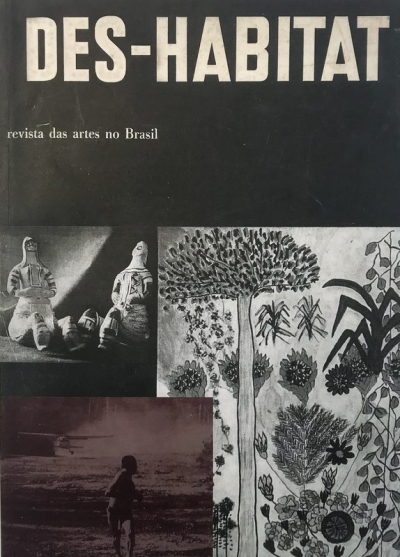
Des-Habitat (revista das artes no Brasil)
Similar to other "militant modernist" publications that flourished at the time, Habitat—the arts and design magazine edited by architect Lina Bo Bardi in the 1950s—not only propagated images of modern art and architecture, but also images of popular and Indigenous crafts and artifacts. In this way it simultaneously introduced its audience to the vocabulary of modernism and vernacular and native forms of cultural expression. Des-Habitat investigates the ways in which the aesthetic language of Habitat framed such objects and images. The project mobilizes a series of design strategies based on re-appropriation, collage, and replacement—procedures central to the graphic language of Habitat—to interrogate the context from which these images emerged as signifiers of modernity within the magazine’s pages. This involves looking at how state policies of pacification of Indigenous groups, which forced resettlement and land confiscation, led to the circulation of Indigenous artifacts and their images for the urban elites. By virtue of its modern visual language, Habitat functioned as a framing device to conceal this colonial context and its own complicit perspective.
Semelhante a outras publicações “modernistas militantes” que floresceram na época, a revista Habitat – publicação de artes e design editada pela arquiteta Lina Bo Bardi nos anos 1950 – não apenas propagava imagens de arte e arquitetura moderna, mas também imagens de artesanato popular e artefatos indígenas. Desta forma, introduzia o seu público simultaneamente ao vocabulário do modernismo e formas vernaculares e nativas de expressão cultural. Des-Habitat investiga a maneira pela qual a linguagem estética de Habitat enquadrava tais objetos e imagens. O projeto mobiliza uma série de estratégias de design baseadas em layout, reapropriação e colagem – procedimentos centrais à linguagem gráfica de Habitat – para interrogar o contexto a partir do qual essas imagens surgiram como significantes modernos nas páginas da revista. Isso envolve observar como políticas de estado de pacificação de grupos indígenas, que forçaram deslocamentos e apropriação de terras, levaram à circulação de artefatos indígenas e suas imagens para as elites urbanas. Em virtude de sua linguagem visual moderna, Habitat funcionava como um enquadramento que ocultava esse contexto colonial, bem como sua própria perspectiva cúmplice.
https://k-verlag.org/books/des-habitat/